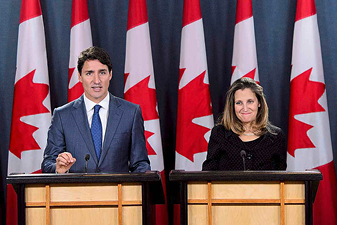|
By Katie Cross, Senior Associate,
Blakey & Agnew
In August 2017, trade stakeholders watched as negotiators from Canada, Mexico and the United States formally sat at the table for the first time to begin reworking the 20-year-old North American Free Trade Agreement (NAFTA). Looming over negotiators were not only domestic interests and competing priorities but also a short window of opportunity. Hoping to finish negotiations before Mexico's 2018 presidential election in July, the negotiators got to work.
Quickly, they found that the July 2018 timeline was overly optimistic. Contested sections of the agreement, including dispute resolution panels, automotive standards, and more, delayed the negotiations. Additionally, other political considerations, such as the enactment of tariffs on aluminum and steel, complicated the talks. Eventually, this led the United States to split up talks between the two countries. First, the U.S. and Mexico committed to bilateral negotiations to resolve various issues, including auto rules of origin. In late-August 2018, President Trump and President Peña Nieto announced that the U.S. and Mexico had reached an agreement for a new trade deal.
On August 31, 2018, President Trump notified Congress of this new trade agreement with Mexico. According to the U.S. Trade Promotion Authority (TPA), Congress must be given 90 days' notice to review the trade pact before it can be signed. At the same time, the U.S. and Mexico re-started negotiations with Canada, setting a deadline of October 1, 2018 for Canada to sign on to the new proposed trade deal.
Prime Minister Justin Trudeau insisted that Canada would not sign on to the deal unless it was in the country's favor. Meanwhile, industry stakeholders such the U.S. Chamber of Commerce and the National Association of Manufacturers called on the negotiations to keep the renegotiated deal trilateral. Members of Congress in the U.S. also urged Canada to sign on to the deal, with some questioning whether or not President Trump would be able to pass the new deal through Congress under TPA should it not include the three countries. They noted that TPA was originally approved for renegotiations of a three country deal and that using it for a two country deal might not be allowed. However, President Trump insisted that the U.S. and Mexico would move forward with the new agreement, regardless of Canadian participation. Representatives from Mexico also indicated they
|

would sign a bilateral deal and suggested that Canada could join later.
Negotiators worked hastily to produce a deal Canada would agree to and on September 30, just hours before the October 1 deadline, Canada agreed to join the trade deal. The new agreement is being called the United States-Mexico-Canada Agreement (USMCA) and, according to a joint statement by U.S. Trade Representative Robert Lighthizer and Canadian Foreign Affairs Minister Chystia Freeland, is a "modernized trade agreement for the 21st century."
Shortly after the announcement of the trilateral agreement, the Association of American Railroads issued a statement in support of the deal and encouraged "Congress to address this new agreement in a very deliberate yet urgent manner." The U.S. Chamber of Commerce welcomed the announcement and commended negotiators "for their commitment to finding a path forward that includes the U.S., Mexico, and Canada."
The three countries' respective legislative entities have 60 days from October 1, 2018 to review, suggest edits and approve the deal. During this time, representatives from the three countries will continue to consult with the private sector to collect additional input on the specifics of the deal. Assuming all parties agree, the three countries will then sign the trade deal in late November 2018, prior to Mexican President Peña Nieto leaving office on November 30, 2018. Following the signing of the deal, each country will need to ratify it. In the U.S., this will likely involve economic reviews as well as other examinations. Stakeholders estimate that the U.S. will finish the analysis process by late February or early March 2019. Then, the draft will be presented to Congress in spring 2019 for review and a vote to either approve or reject ratification of the agreement.
Blakey & Agnew, LLC is a public affairs and
communications consulting firm based in
Washington, DC.
|

